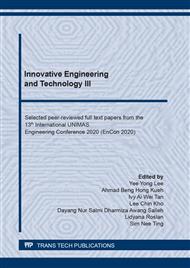p.94
p.103
p.110
p.124
p.138
p.149
p.159
p.169
p.179
Magnetic Ferrous Fluid for Microplastics Extraction Application
Abstract:
The study in microplastics removal using nanomaterials is relatively new and the majority of treatment techniques lies in water treatment plant. This research aims to study an innovative approach to mechanically remove microplastics from polluted water inspired by Fionn Ferreira who won the Google Science Fair in 2019. Experiments are designed and conducted to identify the efficiency of the method with varied oil to nanoparticles ratio. Additionally, possible application of the concept was explored presented as a proof of concept. The technique takes advantage of the relatively low surface tension of oil and immiscible properties in water as an adhesive element between the microplastics and magnetic nanoparticles. Stirring the mixture binds all particle components to the oil medium and then removed from the water using a magnet. Since this is a physical interaction, the technique is not limited to microplastics but other solid particles as well. The results presented in this paper concludes the suggested treatment achieved the highest microplastic extraction percentage at 97.312%. The associated ratio was recorded to be a 1:1 unit volume of oil to nanoparticles. The ratio provides sufficient viscosity and surface tension for ease of microplastics extraction. The novelty of the treatment lies in the reusability of the oiled magnetic nanoparticles as a filter medium. Furthermore, a design inspired by gravity sand filter was presented in this paper as a proof of concept and potential application.
Info:
Periodical:
Pages:
138-145
Citation:
Online since:
May 2021
Authors:
Keywords:
Price:
Сopyright:
© 2021 Trans Tech Publications Ltd. All Rights Reserved
Share:
Citation:


